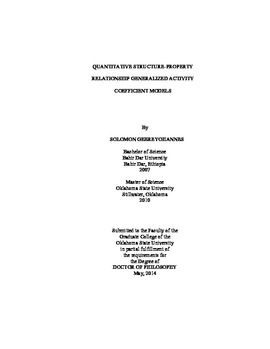| dc.contributor.advisor | Gasem, Khaled A. M. | |
| dc.contributor.author | Gebreyohannes, Solomon Berhie | |
| dc.date.accessioned | 2015-06-17T20:05:58Z | |
| dc.date.available | 2015-06-17T20:05:58Z | |
| dc.date.issued | 2014-05 | |
| dc.identifier.uri | https://hdl.handle.net/11244/14847 | |
| dc.description.abstract | Phase behavior properties of chemical species and their mixtures are essential to design chemical processes involving multiple phases. Thermodynamic models are used in phase equilibria calculations to determine properties, such as phase compositions and partition coefficients at specific temperatures and pressures. In the absence of experimental data, generalized models are employed to predict phase equilibria properties. | |
| dc.description.abstract | The two main objectives of this study are to (1) develop improved generalized models for vapor-liquid equilibria (VLE) and liquid-liquid equilibria (LLE) property predictions using a theory-framed quantitative structure-property relationship (QSPR) modeling approach and (2) implement a new modification to the widely used nonrandom two-liquid (NRTL) activity coefficient model to reduce parameters correlation, which is a limitation of the original model. | |
| dc.description.abstract | In this work, we assembled two databases consisting of 916 binary VLE and 342 binary low-temperature LLE data. Data regression analyses were performed to determine the interaction parameters of various activity coefficient models. Structural descriptors of the molecules were generated and used in developing QSPR models to estimate the regressed interaction parameters. The developed QSPR models for VLE systems provided phase equilibria property predictions within twice the errors obtained through the data regression analyses for VLE systems. For LLE systems, the QSPR models resulted in approximately three to four times the errors found from the regression analyses. Further, our methodology provides a priori and easily implementable QSPR models with a wider applicability range than that of the group-contribution model, UNIFAC. | |
| dc.description.abstract | The newly modified model proposed in this work reduced the NRTL model to a one-parameter model and eliminated the parameter correlation. The original and modified NRTL models yield comparable accuracies in representing experimental equilibrium properties. The benefits of our modification include easy generalizability of the parameters, ability to classify VLE behaviors based on a single model parameter and fewer convergence problems in parameter regressions. | |
| dc.format | application/pdf | |
| dc.language | en_US | |
| dc.rights | Copyright is held by the author who has granted the Oklahoma State University Library the non-exclusive right to share this material in its institutional repository. Contact Digital Library Services at lib-dls@okstate.edu or 405-744-9161 for the permission policy on the use, reproduction or distribution of this material. | |
| dc.title | Quantitative structure-property relationship generalized activity coefficient models | |
| dc.contributor.committeeMember | Robinson, Robert Louis | |
| dc.contributor.committeeMember | Ramsey, Joshua D. | |
| dc.contributor.committeeMember | Hagan, Martin T. | |
| osu.filename | Gebreyohannes_okstate_0664D_13266.pdf | |
| osu.accesstype | Open Access | |
| dc.type.genre | Dissertation | |
| dc.type.material | Text | |
| thesis.degree.discipline | Chemical Engineering | |
| thesis.degree.grantor | Oklahoma State University | |
